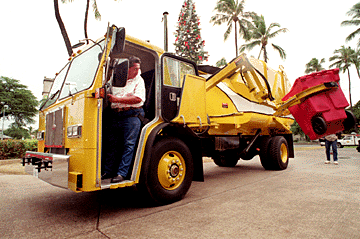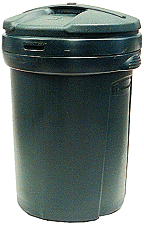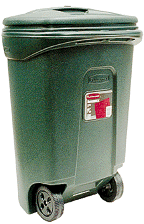



 But keeping up with the Johnsons, can-wise, carries certain civic responsibilities. It's an offer you can't refuse. I mean, a refuse you can't offer.
But keeping up with the Johnsons, can-wise, carries certain civic responsibilities. It's an offer you can't refuse. I mean, a refuse you can't offer.
It's not your can, for one thing. It belongs to the city. They paid about $60 each (a bulk rate) for them. It's assigned to you; or actually, to your residence. There's a serial number on the side that's unique to each container. While some homeowners are painting their addresses on the sides of the can (that's permissible), it's easier just to keep track of your serial number, in case your can gets mixed up with the neighbor's.
When you move, leave the can behind.
On collection days, the refuse folk have an easier time if the container is on the curb and at least 5 feet from any obstruction. This means mailboxes, cars, fire hydrants, telephone poles or that pile of cinder blocks you plan on using someday. And they want it there by 6 a.m., with the handle pointed toward the house.
On non-collection days, they want it away from the curb. This may be difficult on steep driveways, particularly if the homeowner is older, says Refuse Collection Administrator Dave Shiraishi. "In that case, they should just move it as far from the curb as they can, and bring the trash to it."
(Some "planned" neighborhoods may have regulations against leaving the city container in sight on non-collection days.)
If the trash is not in the can, it won't be picked up. We're talking "regular refuse," which includes grass clippings and yard trimmings. The lid should be closed. Household trash should be in bags inside the can. Stuff like sawdust, barbeque ashes and broken glass - which could scatter as it's being dumped into the maw of the truck - should be wrapped or bagged.
The city frowns on placing heavy items such as "appliances, furniture, engine parts, concrete, concrete blocks, rocks, soil" and so on in the container. Call your Bulky Items Disposal neighborhood number for a pick-up. Call the same number to pick up small dead animals, but if your dead animal is more than 70 pounds, you're on your own. It must be transported to a municipal landfill.
 And the city wants you to hose out and clean the container occasionally.
And the city wants you to hose out and clean the container occasionally.
If you "violate the provisions of proper preparation and placement of refuse," according to a city informational handout, you can be fined up to $250 under City Ordinance No. 4339.
Even if you coddle your container, it might have a wheel fall off, or something equally disastrous. "If something goes wrong, call us and we'll have it fixed," said Shiraishi. "They're warrantied by the manufacturer for 10 years."
Now, if you're wondering if and when your neighborhood will become part of the city's automated system, hold on. The process is a gradual one, Shiraishi, and won't occur overnight.
"We have to negotiate with the unions on each step, so we're just taking this year by year. We don't really have a schedule."
A change-over is also determined by routes, not neighborhood divisions. Most of the automated zones so far have been in hillside areas, he said.
Routes currently automated include those in Ahuimanu, Aiea, Aina Haina, Aliamanu, Foster Village, Haiku, Halawa, Hauula, Hawaii Kai, Heeia, Kaaawa, Kahaluu, Kaimuki, Kaneohe, Kapaa, Kapahulu, Kapolei, Kapunahala, Kuliouou, Laie, Maili, Makakilo, Manoa, Mililani, Moanalua, Moanalua Valley, Nanakuli, Newtown, Niu Valley, Pacific Palisades, Pearl City, Pearl Ridge, Punaluu, Royal Summit, Salt Lake, Village Park, Wahiawa, Waiahole, Waialae Iki, Waialae-Kahala, Waialae Nui, Waianae, Waikane, Waipio and Waipio Gentry.
In 1997, the only new automated routes will be in Wahiawa and Waianae.
For information about trash, look in the phone book under 1) Honolulu City & County, 2) Public Works, 3) Refuse Collection.
